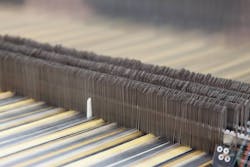As a family-owned company, at Glen Raven—maker of Sunbrella—there is a personal investment in the business’s operations, team, and products. With a rich history
spanning more than 135 years, Glen Raven and Sunbrella have celebrated many milestones that have been influential far beyond just the brands themselves, changing the face of the textile industry as it once was and as we know it today.
While Glen Raven’s shareholders today are all family members, Leib Oehmig, the current CEO, is the first from outside the family—succeeding Allen Gant, Jr. However Oehmig has worked for the company since he graduated college, so he is trusted to continue the leadership legacy that was held for three generations, starting in 1880 in Alamance County, N.C. The Glen Raven/Sunbrella story spans from introducing pantyhose in the 1940s to providing on-site health and wellness resources for their facilities’ staff. The following are some notable milestones that have brought Glen Raven and Sunbrella to where they are today.
A STAR IS BORN
While Sunbrella technology was developed in the late 1950s, it was first commercialized in 1961 as a fabric for outdoor awnings. “Right out of the gates it had a five-year warranty; there was not another textile anywhere in this market with a warranty,” noted Gina Wicker, Sunbrella’s director of A&D markets. “Proprietary solution-dyed acrylic formulations were developed with a top textile chemical company of that time.” Glen Raven’s goal with Sunbrella was to create a polymer that would stand up to high UV exposure and would not degrade. “If a red umbrella rips in two years, it doesn’t matter that it’s red,” she noted. “The main target then and now is a polymer that resists fading and strength degradation for a complete performance story.”
INNOVATIVE OPPORTUNITIES
In the early to mid-1970s, an opportunity came along for the exceptional performance of Subrella to be applied to marine canvas. “For many marine applications or boat covers, breathability was key because it prevented buildup of mold, mildew, and musty smells in the cockpit environment [of a boat],” explained Vince Hankins, director, industrial markets. “That was the next chapter in Sunbrella’s existence.” Another significant development was moving into outdoor furniture and decorative applications, which started in the early 1980s. “Up until then, vinyl and other seating surfaces weren’t terribly attractive or comfortable,” he added. “Sunbrella was able to offer upholstery cushions with durable and aesthetically appealing fabric.”
OPTIMIZING SPACE AND OPERATIONS
From 1992 to 1994, a team that included Randy Blackston, current VP of operations, analyzed both the world of textiles and outside industries to facilitate optimal construction and operations at Glen Raven’s Anderson, S.C., facility. “For two years we looked at the general textile industry,” Blackston said. “We were looking at the quality products we currently make but asked how we could make them better. We started looking globally, and the next step was to look outside of the industry. We examined automotive manufacturing, tires, and more. We visited NASCAR to look at how they did a quick change with the pit crew. We looked at how contaminated air from hospital operating rooms was evacuated and how super-washed clean air was introduced.” Operations were analyzed and adjusted over time, from the 1994 groundbreaking to the plant’s completion in 1997. “We started spinning yarn in the spring of 1995,” Blackston noted. “It was a design-build process when we started moving.”
“‘GREEN’ SINCE IT WAS JUST A COLOR”
When the Sunbrella brand was invented, Glen Raven made a conscious decision to manufacture a product that had a lifecycle story. With 40 worldwide locations today, the company’s journey to becoming landfill-free—which was achieved in all domestic plants in 2013 and internationally in 2015—began in the 1990s when it developed the means to automatically control facility waste streams. Glen Raven set a goal to reduce energy used per pound of product made by 20 percent; it exceeded that when it recently added its solar array at the Anderson plant to its other efforts, including saving 10 million gallons of water per year over the last 11 years. “Our sustainability story isn’t about recycling more; it’s about using less,” Blackston noted.
HERE COMES THE SUN
In June of 2017, installation of a solar array was completed at the Glen Raven plant in Anderson. “We don’t just look at what we can reuse or recycle; we look at how we can change processes so we don’t have to bring in additional resources,” Wicker said. “The solar array is an example of that.” When wooded property at the Anderson facility became infested with parasites, all of the trees had to be taken down. With that, the company saw an opportunity to make good use of the newly vacant land. Officially unveiled on October 4, the 3,076-panel display will power 100 percent of the lights at the Anderson plant and will offset a significant amount of carbon annually. Solar energy isn’t new to Glen Raven; the company also has an array installed at its plant in Norlina, N.C.
Photography courtesy of Glen Raven
